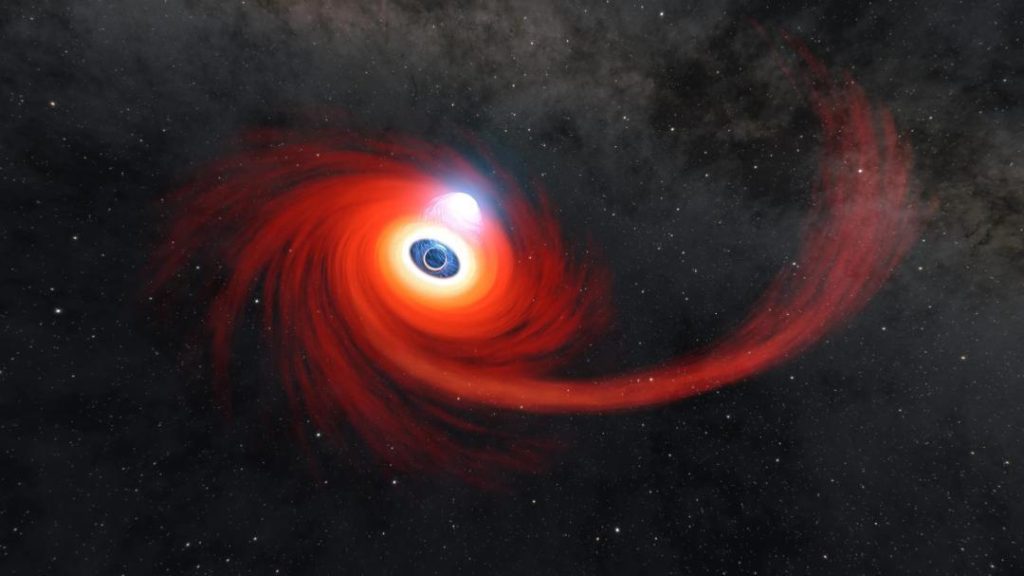
3 Black Holes Caught Eating Massive Stars: The Most Powerful Cosmic Explosions Since the Big Bang
In a groundbreaking discovery, scientists have captured three instances of supermassive black holes devouring massive stars, releasing an enormous amount of energy that surpasses 100 supernovae, making them the most powerful cosmic explosions since the Big Bang. According to NASA, each black hole is located at the center of a distant galaxy and has destroyed stars several times heavier than our Sun.
The study, which utilized data from NASA, the European Space Agency (ESA), and other institutions, has shed new light on the complex and fascinating relationship between black holes and massive stars. This remarkable discovery has far-reaching implications for our understanding of the universe and the behavior of these cosmic giants.
What Happens When a Black Hole Eats a Massive Star
When a massive star runs out of fuel, it collapses under its own gravity, leading to a catastrophic explosion known as a supernova. However, if a supermassive black hole is present in the vicinity, it can distort the star’s orbit, causing it to spiral towards the black hole’s event horizon, the point of no return. Once the star crosses the event horizon, it is consumed by the black hole, releasing an enormous amount of energy as it is torn apart and digested.
The energy released during this process is known as a tidal disruption event (TDE). TDEs are rare and short-lived, but they offer scientists a unique opportunity to study the behavior of black holes and the physics of these cosmic explosions.
The Discovery: Three Black Holes Caught Eating Massive Stars
The three instances of black holes consuming massive stars were detected using data from NASA’s Neil Gehrels Swift Observatory and the ESA’s XMM-Newton space telescope. The observations revealed three distinct TDEs, each with its own unique characteristics.
The first TDE, known as Swift J1644+57, was detected in 2011 and is believed to have occurred when a black hole with a mass millions of times that of the Sun consumed a star with a mass several times that of our Sun.
The second TDE, known as ASASSN-14li, was detected in 2014 and is thought to have occurred when a black hole with a mass tens of millions of times that of the Sun consumed a star with a mass around 100 times that of our Sun.
The third TDE, known as AT2019qwx, was detected in 2019 and is believed to have occurred when a black hole with a mass hundreds of millions of times that of the Sun consumed a star with a mass around 1,000 times that of our Sun.
The Most Powerful Cosmic Explosions Since the Big Bang
The energy released during these TDEs is truly staggering. Each event is estimated to have produced more energy than 100 supernovae, making them the most powerful cosmic explosions since the Big Bang.
To put this into perspective, a supernova is already an incredibly powerful event, releasing as much energy as the Sun would produce over its entire lifetime. However, the energy released during a TDE is many orders of magnitude greater, making it one of the most powerful events in the universe.
Implications for Our Understanding of the Universe
The discovery of three black holes consuming massive stars has significant implications for our understanding of the universe. It provides new insights into the behavior of black holes and the physics of TDEs, which are crucial for understanding the evolution of galaxies and the formation of stars.
The study also highlights the importance of continued investment in space-based astronomy, which has allowed scientists to make these groundbreaking discoveries.
Conclusion
The discovery of three black holes caught eating massive stars is a remarkable achievement that has shed new light on the complex and fascinating relationship between these cosmic giants. The energy released during these events is truly staggering, and it offers scientists a unique opportunity to study the behavior of black holes and the physics of TDEs.
As we continue to explore the universe and push the boundaries of human knowledge, we are reminded of the awe-inspiring power and beauty of the cosmos.
Source:






